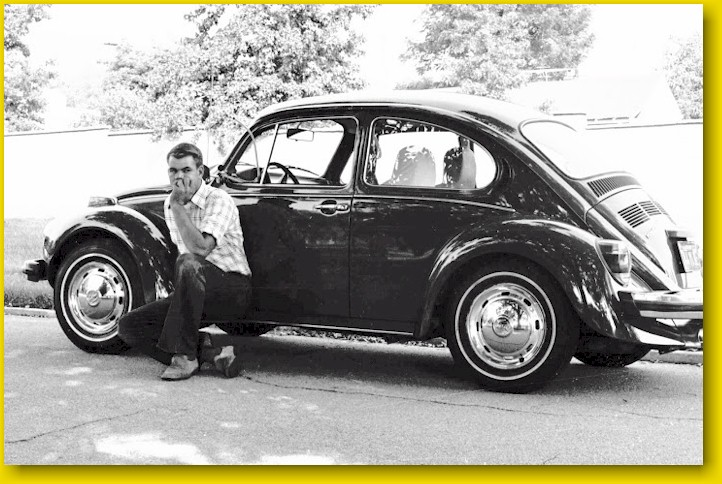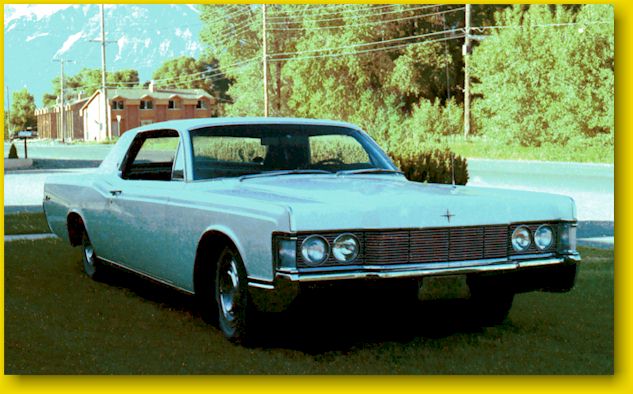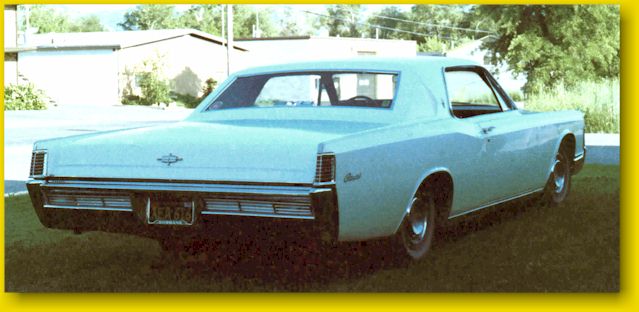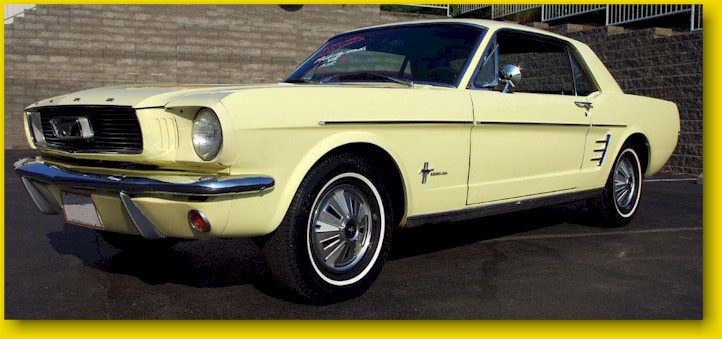Family Cars

Cars aren't just transportation in Southern California - they're a birthright.
We may not have had opulent taste in interior decor, but we certainly were ambitious with cars! This photo shows the Clark Fleet in 1978. Mom's car was that white 1975 Cadillac Eldorado parked in the driveway, a classy piece of junk if ever there was one. It had a 500 cubic inch engine - but don't be impressed... it was easily out-performed by smaller and more reliable V-8's. But I did something about that later on. In flagrant defiance of the California emissions laws I knocked out the gas nozzle restrictor and started filling it up with premium gas. I also retuned the engine for the better gas, and the difference was astounding - I could easily smoke the front tires when I tromped on the pedal, and the continual pinging went away.
 The Eldorado had a stately ride, which is to say that it coasted down the street like a large naval vessel. Zero maneuverability. However, being inside was nice, kind of like being in a turn of the century dark red velvet-lined coach. It was very quiet and cozy inside, and the stereo (8 track!) sounded pretty good.
The Eldorado had a stately ride, which is to say that it coasted down the street like a large naval vessel. Zero maneuverability. However, being inside was nice, kind of like being in a turn of the century dark red velvet-lined coach. It was very quiet and cozy inside, and the stereo (8 track!) sounded pretty good.
One thing I could never seem to fix, however, was the ongoing electrical problems we had, as well as the classic Cadillac ride (the trunk was lower than the front end). We made many interesting family trips in this car, however, and my individual use of it was pretty memorable, too. One trip that stands out was taking it to Las Vegas, where Mom and Dad and I decided we'd spend the Thanksgiving of 1978. On the first night I had a great time playing the casinos; after all, I was now of age to do so. But late that night I caught a flu or something and got very sick. I recall watching "The Midnight Special" on TV in the hotel room - the guest host was Ted Nugent - but the rest of the night I was feverishly hallucinating all sorts of odd, quasi-religious things. When it came time to drive back home, I couldn't, and spent the entire time spread out in the back seat, sleeping. I was as weak as a puppy.
Eventually Mom tired of this car, and we replaced it with a 1979 Mercury Marquis, which was the last car she ever owned.
The family car before the Eldorado was much better: a 1972 Ford LTD Brougham, shown here in August 1972 a day or two after we bought it. The paint job was a metallic green-gold which was the nearest thing to avocado the auto manufacturers were producing. I loved this car. It was big, the interior was quiet for listening to classical music on KFAC, the air conditioner worked well, the 427 CID engine was responsive and it was green. Even the dashboard gauges glowed a subtle and mysterious green. What's more, I liked the vinyl top on this particular model. Being the car in which I learned to drive, it holds fond memories for me. (I blog about it here) What's more, it was a pretty car - I like the big, bold car auto designs from the Seventies.
That red car is Dad's 1968 Porsche 912. While it seemed to require constant tuning and work by Dad's auto mechanic Bela - who was used to him from ownership of a Karmann-Ghia, described below - Dad loved it. I think for him it symbolized his financial arrival. He got a real kick out of owning it. He told me that one time he was parked at a drive-in burger joint, and heard some kid tell another, "Look at the old man in the Porsche!" He found this amusing. He was certainly a familiar site in Burbank, driving about. Once, Mike McDaniel and I were seated in my Porsche (the black 911) and stopped at a traffic light, where we saw my father stopped, awaiting his light. Mike observed that the little door to Dad's gas tank was open, and the gas cap appeared to be missing. Apparently Dad had just tanked up and had forgotten to replace the cap. So, I honked the horn to get his attention for what seemed a ridiculously long time; after awhile it got funny. We could see him looking around to try to figure out who was honking, but for some reason never saw us. Finally his light turned green, so he turned in our direction, looked right at us and stuck his arm out of the window, middle finger extended - then stomped the gas and roared through the intersection. Mike and I were incapacitated with laughter. When we got home we demanded to know why he had flipped us off, and his comment was, "Oh, was that you honking the horn?"
The 912 was stolen from him just before Christmas, 1981. Mom told me a story that one evening Dad looked out the front window to where his 912 would normally be parked, and became very sad. His next car, a 1975 Porsche 914, wasn't quite as good. (He also didn't fit into it as well.) I arranged for my parents to purchase it when I was at BYU, and drove it home for Dad. Eventually I inherited it.
 Dad's previous car to that red Porsche was a 1965 VW Karmann-Ghia shown in another image. In the photo it's red, but later on he had it painted a color used (I think) on the 1969 Ford Maverick, "Grabber Orange." It was a cheap Earl Sheib paint job, however, and peeled. Then he had it painted silver - another cheap paint job and more peeling. Finally, he painted it white. Dad had a unique style of driving this car which required high RPM's and a sudden release of the clutch pedal. Consequently, he wore out clutch plates every six or eight months. When this happened he'd take the car to the local Hungarian mechanic, Bela, who would chastise him for his driving habits. (A measure of Bela's integrity - any other mechanic would simply shrug his shoulders and figure Dad was good for business.) Once, Dad drove to Bela's complaining that the latest clutch plate he installed was no good. Bela argued back that he had installed a special heavy duty disk for him because he followed him away from the shop one day, and noted his high RPM technique. Being thus caught, Dad had little to offer in his defense.
Dad's previous car to that red Porsche was a 1965 VW Karmann-Ghia shown in another image. In the photo it's red, but later on he had it painted a color used (I think) on the 1969 Ford Maverick, "Grabber Orange." It was a cheap Earl Sheib paint job, however, and peeled. Then he had it painted silver - another cheap paint job and more peeling. Finally, he painted it white. Dad had a unique style of driving this car which required high RPM's and a sudden release of the clutch pedal. Consequently, he wore out clutch plates every six or eight months. When this happened he'd take the car to the local Hungarian mechanic, Bela, who would chastise him for his driving habits. (A measure of Bela's integrity - any other mechanic would simply shrug his shoulders and figure Dad was good for business.) Once, Dad drove to Bela's complaining that the latest clutch plate he installed was no good. Bela argued back that he had installed a special heavy duty disk for him because he followed him away from the shop one day, and noted his high RPM technique. Being thus caught, Dad had little to offer in his defense.
(Bela was an interesting little fellow. He owned a shop at the intersection of Buena Vista and San Fernando Road. Volkswagen engines and transmissions were strewn about the yard, and at night fierce dogs roamed. Commendably capitalistic - no doubt due to firsthand experience with socialism in Hungary - his office had a big sign that read, "I'M FIGHTING POVERTY - I'M WORKING!" He employed Vietnamese mechanics, and once my father told me in an amused tone, "A guy named 'Dung' is working on my clutch.")
It was always fun to be in the living room of the house when Dad arrived home. One Saturday morning Mike and I were in the living room eating donuts, and observed Dad's arrival. The procedure never varied: Dad would slowly coast to the bottom of the sidewalk ramp to align himself with the short driveway (which he painted electric blue). Then he'd rev up the engine to an alarming speed. With a sudden release of the clutch pedal the car would lurch forward, and only a swift application of the brake would keep the car from traveling through the garage door and into our pool hall. Half the time the car would then stall. This procedure was murder on the car's internal parts, of course, but really entertaining to watch.
Dad sold the Karmann-Ghia when the Porsche 912 caught his eye.

As for me, after three years of ownership I traded in my 1974 VW Super Beetle - my first car - and bought the black 1971 Porsche 914 shown here and in another view. (That's my friend Mike standing by it.) I am happy to note that, unlike Dad, I have never had to replace a clutch on any car I have ever owned. But my day is coming - I know it is. We all become our fathers.
In 1978, feeling a sense of entitlement for accomplishments I certainly didn't merit in any way, I bought a brand new mint green metallic Chrysler LeBaron. That's me sitting on it. You may note the sideburns and tan corduroy pants and sweater - my idea of color-coordinated and "attractively dressed." This purchase was more a case of immaturity than need, or perhaps I was caught by the new car bug while visiting a dealership for fun (a bad habit). After all, what was a twenty-two year old doing driving around in a car marketed for Sixtysomethings? Nevertheless, I bought the car, adapted a cassette player to play over the already-installed speakers (it only came with an AM-FM stereo) and started making payments. But when I realized my insurance payments were more than my car payments - a result of speeding tickets in the Porsche 914 - I unloaded the car to an old French-Canadian and bought my next ride. After all, while the LeBaron was a nice car, it really wasn't me. A leak in the taillight assemblies didn't endear the car to me, either. They were big and rectangular, and when it rained they'd fill up and look like red plastic aquariums, then they'd eventually drain into wells in the trunk. I brought the car back to the dealership a number of times for Mr. Goodwrench to fix, to no avail. Cars like this and service like that was why Japanese cars became enormously popular in the Eighties.
The only thing that I recall about the French-Canadian gent who bought my car was that he pronounced Third Street (in Burbank) as "Turd Street."


My final car of the Seventies was a 1968 Lincoln Continental, which I purchased for about a thousand dollars in April, 1979; it is shown above. The Lincoln Continental by this time had acquired a coolness and cachet based on Mike's use of them during evening cruises; certainly Mike and I became Lincoln enthusiasts in spite of their numerous faults. I loved the smooth, elegant, boxy lines. (The old joke about Lincoln Continentals was that when you bought one you got the car and the box it came in, too.) This one was owned by a retired engineer, who lived in the nicer part of Burbank in the hills and gave me the distinct impression of being a member of the leisure gentry. When he showed it to me, he described the trunk as having plenty of room for his golf clubs. (Well! Can you also fit a bottle of champaign in the glove box?) This fellow had installed an after-market cruise control which had an interesting characteristic: at a near-freeway speed, when engaged at the press of a button, the vacuum diaphragm would quickly close, pulling on a cable connected to the carburator. This would cause several hundreds of horsepower to immediately make the big car lurch forward to the set speed - and probably drain a teacup of gasoline in doing so. It was a hoot to experience, however, and we called the cruise control on that car the "hyperspace drive," after Star Wars.
Despite all the repairs I had to pay for, I loved that Lincoln. It was big, roomy, comfortable, quiet and strong. The forest green (my favorite color) leather seats gave off a slight musty, aged smell that suggested the interior of an old library, or a London club. Not that I had ever actually been in a London club, of course, but you get the idea. Gas mileage was awful - about 7 mpg city, 11 mpg highway. But I was making good money at Lockheed and didn't mind paying $40 every week for gas (a lot, in those days). I was also pleased with the sound I got out of a Radio Shack 100 watt amplifier/equalizer run to the big speakers in the doors and rear deck.
In addition to a certain nobility, the Lincoln had real personality as well. For instance, a sudden jerk of the steering wheel leftwards could often launch the big passenger-side hubcap spinning in a straight line towards (imagined) pedestrians, other cars, etc. The lights were fun: I had installed airplane landing lights as the secondary lights (you can see them in the photo), but since I didn't install a relay, after a minute or two the electrical system would begin to overload and the lights would flash on and off on a regular beat. At 100,000 candlepower each, that was some light show. The "hot" light on the dashboard would glow until the engine warmed up, then it would go off. And I could keep the engine running after I turned and removed the key from the ignition by keeping my foot on the brake. When I removed my foot, the engine would stop. Personality... if the beast had spoken to me via the radio, I wouldn't have been too surprised.
In February 1980, after many repairs, I finally drove this car up to Provo, Utah, to begin college at Brigham Young University. My fiancee, now my wife of 25+ years, rode up there with me. But all that - college, marriage, home ownership, raising kids, Civil War reenacting, rugby, electric bass-playing - is another story, perhaps for a website describing life in the Eighties. Suffice to say that when I finally got rid of the Lincoln it went to a good home: Mike McDaniel!

Descriptively working backwards in time, in 1966 we bought a Ford Mustang, in a pale "springtime yellow" paint. It had a six-cylinder engine and was barely furnished - but, being a Mustang, it had all sorts of style. When we first got it, other people driving Mustangs would honk at us, indicating a certain pride of ownership. Gulf gas stations used to give away orange plastic horseshoes that were meant to be affixed to bumpers, and we did this, thinking ourselves clever. (Get it? A horseshoe? On a Mustang?) The interior was black and looked kind of racy; I certainly liked the T-handle transmission control. We kept this car until August 1972, when we bought the LTD. What finally doomed it was my growing taller and not fitting into the back seat, and a desire for air-conditioning to use on the trips to Las Vegas. Not to mention mechanical problems arising from our neglectful maintenance practices. I'm sure my parents had the oil changed in their cars every now and then, but I don't ever recall it and I'm sure it was long after the schedule called for it. (I blog about this Mustang here.)

Working descriptively even further backwards in time, in 1963 (I think it was) we bought a 1959 Ford Fairlane 500. We had rented one for some reason and liked it enough to buy one. This car's most distinguishing feature was its color: a heavily-pigmented sea green. It also had a metallic green interior. Green being my favorite color, I loved it. The speedometer was interesting to me; I thought it looked like a tombstone. I also liked the Thunderbird insignias on the front hood, indicating a Thunderbird engine.
However, that Thunderbird engine gave us loads of problems and we finally dumped the car for the Mustang.

The first car I can recall - it also appears in old home movies - is our white station wagon, a 1957 Ford Country Squire with fake wood siding. I remember the dashboard very well. (I always remember the dashboards of our cars.) The only other thing I recall about it was that one day Dad was vacuuming the interior in it and for some reason of my own I put the vacuum nozzle to my ear. I had a painful earache for the rest of the day. That learned me!